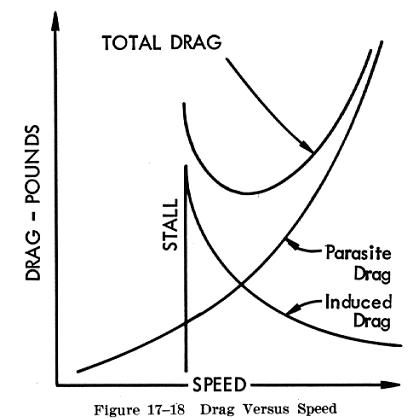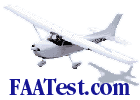| Straight and Level Flight
All of the principal items of flight performance involve steady
state flight conditions and equilibrium of the airplane. For the airplane to
remain in steady level flight, equilibrium must be obtained by a lift equal to
the airplane weight and a powerplant thrust equal to the airplane drag. Thus,
the airplane drag defines the thrust required to maintain steady level flight.
All parts of the airplane that are exposed to the air contribute
to the drag, though only the wings provide lift of any significance. For this
reason, and certain others related to it, the total drag may be divided into two
parts, the wing drag (induced) and the drag of everything but the wings
(parasite).
The total power required for flight then can be considered as
the sum of induced and parasite effects; that is, the total drag of the
airplane. Parasite drag is the sum of pressure and friction drag which is due to
the airplane's basic configuration and, as defined, is independent of lift.
Induced drag is the undesirable but unavoidable consequence of the development
of lift.
 |
While the parasite drag predominates at high speed, induced drag
predominates at low speed (Fig. 17-18). For example, if an airplane in a
steady flight condition at 100 knots is then accelerated to 200 knots, the
parasite drag becomes four times as great but the power required to
overcome that drag is eight times the original value. Conversely, when the
airplane is operated in steady level flight at twice as great a speed, the
induced drag is one-fourth the original value and the power required to
overcome that drag is only one-half the original value.
The wing or induced drag changes with speed in a very
different way, because of the changes in the angle of attack. Near the
stalling speed the wing is inclined to the relative wind at nearly the
stalling angle, and its drag is very strong. But at ordinary flying
speeds, with the angle of attack nearly zero, the wing cuts through the
air almost like a knife, and the drag is minimal. After attaining a
certain high speed, the angle of attack changes very little with any
further increase in speed and the drag of the wing increases in direct
proportion to any further increase in speed. This does not consider the
factor of compressibility drag which is involved at speeds beyond the top
speed of most general aviation airplanes. |
To sum up these changes, for a typical, moderately powered
airplane: As the speed increases from stalling speed to top speed, the induced
drag decreases and parasite drag increases. As a result the total drag decreases
for the first part of the range and then increases again.

When the airplane is in steady, level flight, the condition of
equilibrium must prevail. The unaccelerated condition of flight is achieved with
the airplane trimmed for lift equal to weight and the powerplant set for a
thrust to equal the airplane drag.
The maximum level flight
speed for the airplane will be obtained when the power or thrust required equals
the maximum power or thrust available from the power plant (Fig. 17-54). The
minimum level flight airspeed is not usually defined by thrust or power
requirement since conditions of stall or stability and control problems
generally predominate.
 |
FAATest.com
- Aviation Library
Dauntless
Software hosts and maintains this library as a service to pilots
and aspiring pilots worldwide. Click
here for ways to show your appreciation for this service.
While much of this material comes from the FAA, parts of it are (c) Dauntless Software, all rights reserved. Webmasters: please
do not link directly to individual books in this library--rather,
please link to our main web page at www.dauntless-soft.com or
www.faatest.com. Thanks! |
|


